Soccer drills for technique attack / offense
Organization:
Divide the team into 2 groups. Preferably have both groups finish with the same exercise on 2 goals.
Exercise A:
Pass the ball, lay it wide, play into the corner, cross to the striker and finish.
Exercise B:
Pass the ball, lay it wide, play into the corner and cross to the midfielder. After a combination with the striker the midfielder finishes.
If everything goes well you can ask them to score with a volley at the end.
Notes:
Scoring in this exercise is most important. It is allowed to play through the air, as long as this is done accurately
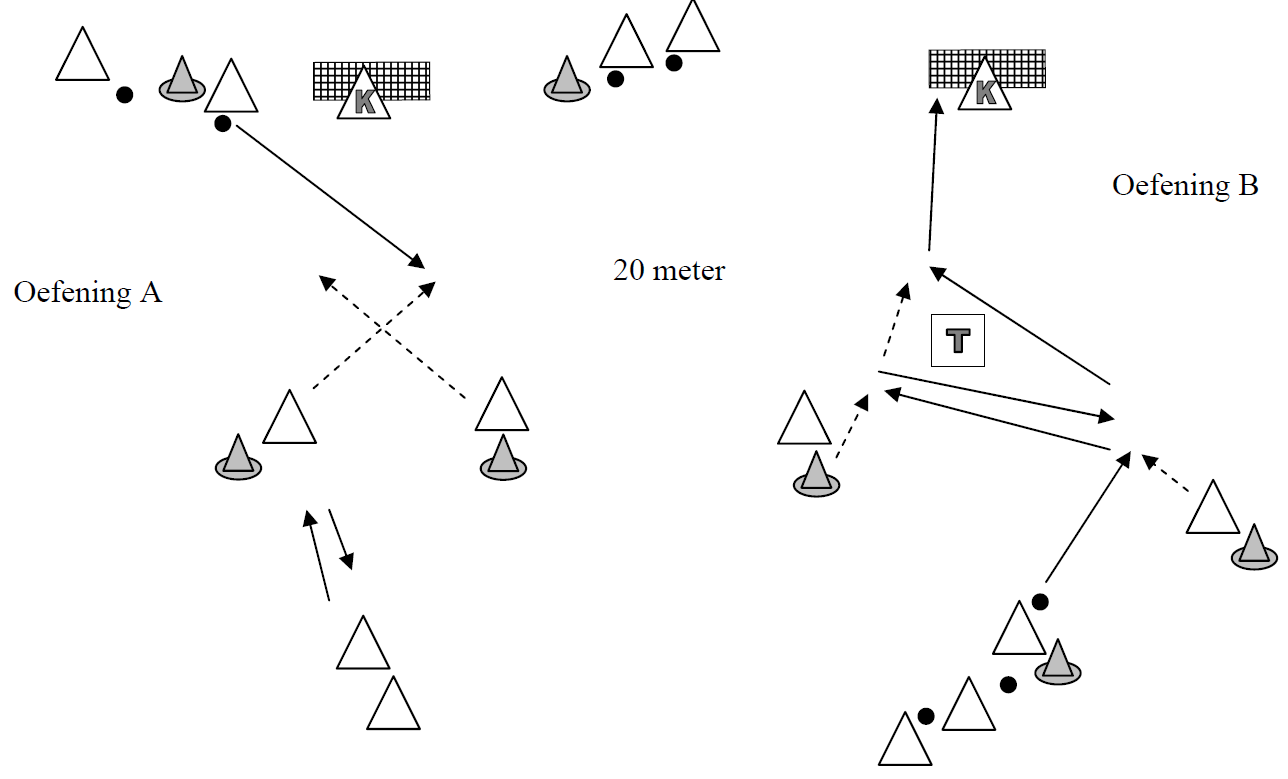
Organisation:
In exercise A the team is divided into two groups, one on the left and one on the right.
A cross is hit from the back line. The incoming attackers cross each other. The player who shot at the goal collects the ball and goes behind. The player who hit the cross becomes the attacker.
In exercise B, the ball is shot on goal after a handball and 1-2 combination. You can do this yourself,
After the exercise has gone well, you can act as defender here.
The players move on.
Points of attention:
Movement towards the ball.
Playing clean and hard.
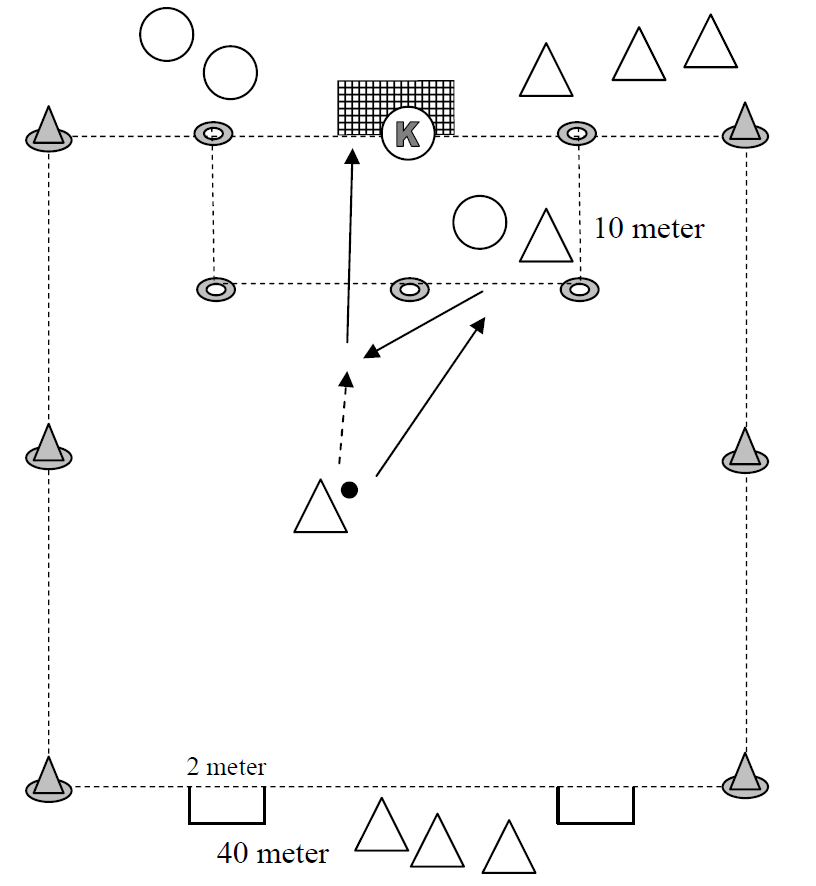
Organization:
2 attackers against 1 defender + a goalkeeper.
The attacking team can score from outside the 10 meter zone by shooting directly after the handball
. If they enter the 10-meter zone, they can choose how to score.
After a chance, missed or hit, or when the ball goes out to the sides, the ball is exchanged.
The defender can score on the 2 small goals.
Points of attention:
Move to the side to make room for your team-mate.
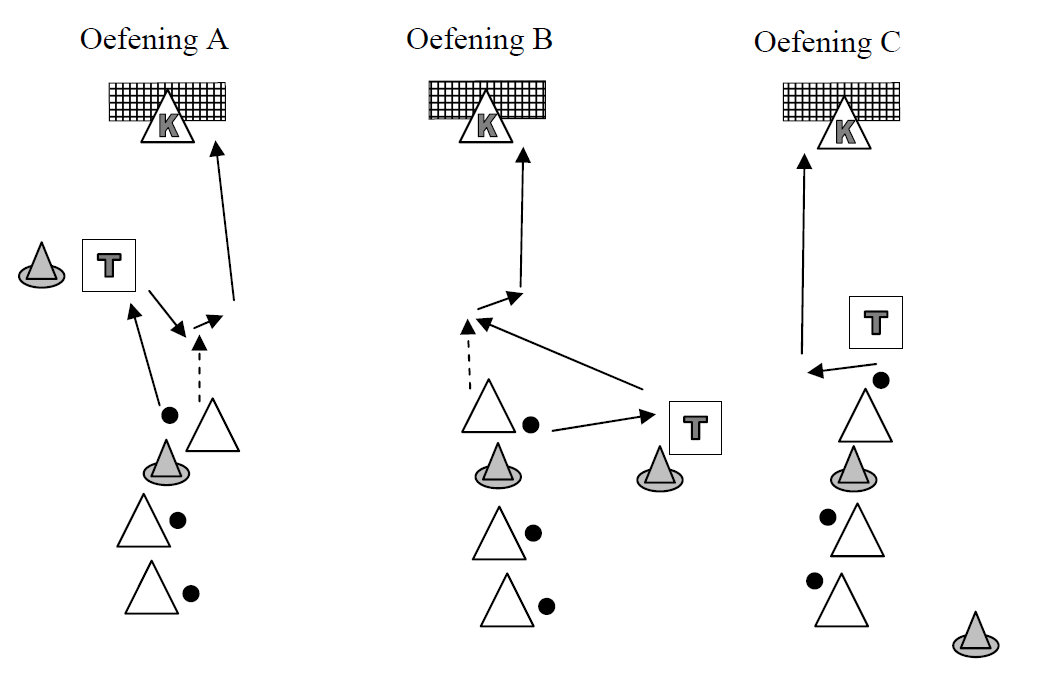
Organization:
Divide the team into two groups. Everyone has a ball. Each group near a goal with a goalkeeper. There are different ways to finish on goal.
Exercise A is with a handball. The players have to set the ball up with the outside of their foot so that they can shoot at the goal in one fluent movement.
In exercise B the ball is played to them from the side. They receive the ball with their left and shoot with their right. If the pass from the trainer comes from the left, they take the ball with the right and shoot with the left.
In exercise C they come up to the trainer and cut the ball with the inside or the outside of the foot. After the cutting movement they must try to shoot directly.
Points of attention:
Look at their standing leg at the moment they shoot.
Do they estimate the ball speed correctly?
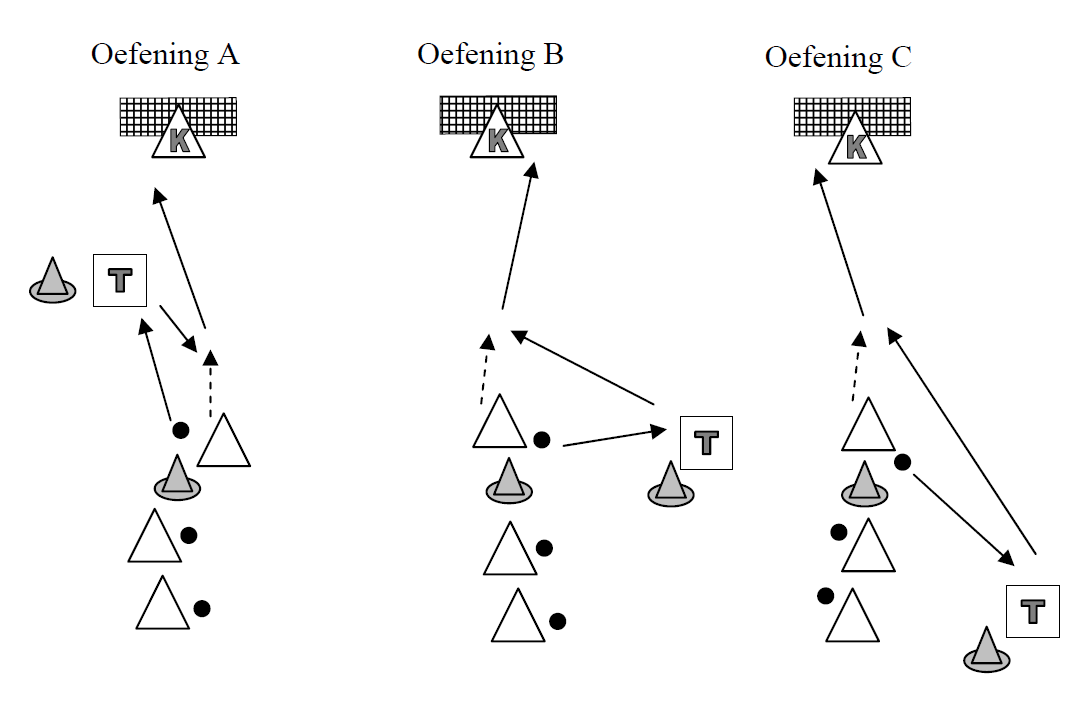
Organization:
Divide the team into 2 groups. Everyone has a ball. Each group near a goal with a goalkeeper.
There are different ways to finish on the goal.
Exercise A is with a handball.
In exercise B the ball is played to them from the side.
In exercise C the ball comes from behind.
If everything goes well, you can also try other variations.
For example: throwing up the ball; throwing the ball over a player who has his back to the goal.
Some remarks:
With F-pupils it is recommended to play handball yourself. This is to keep the pace of the exercise
.
In the second year of E-pupils, you can also let them pass.
Points of attention
Look at their standing leg at the moment of
shooting.
Do they estimate the ball speed correctly?
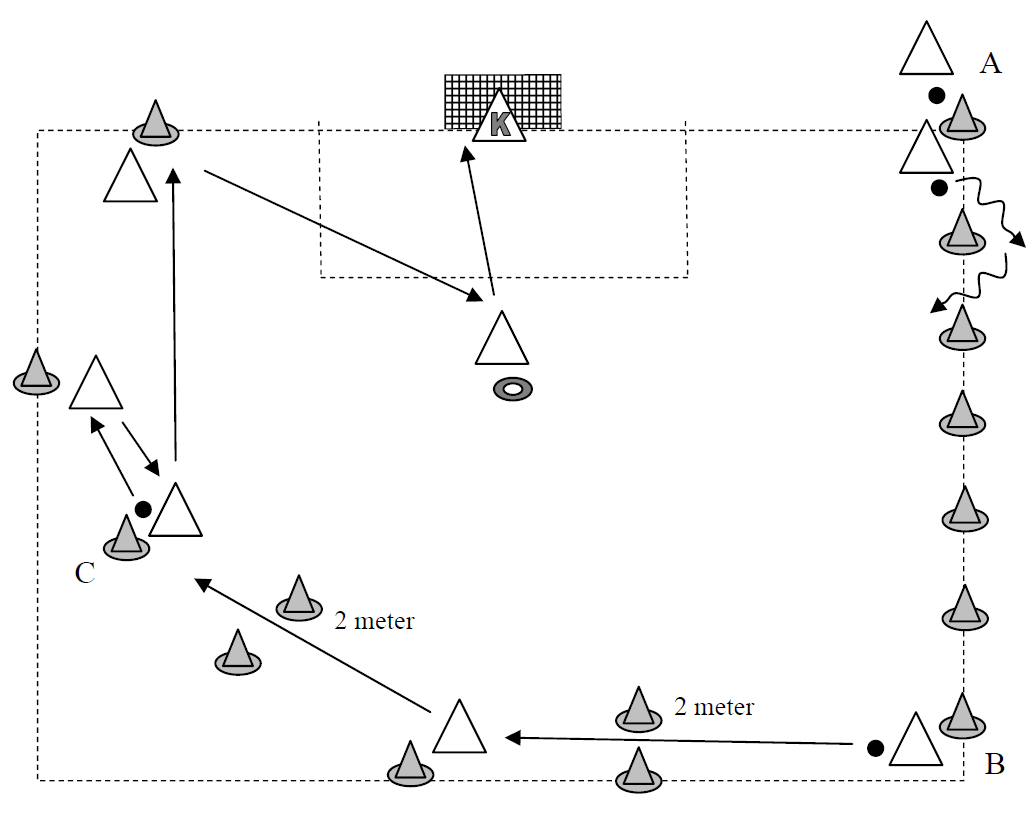
Organisation:
Start with dribbling, then shoot through gates, via a handball comes a cross which is
shotat goal
.
Depending on the number of players you can
startwith 2 balls, on position A and C, or with 3 balls at the same time
.
Everyone shifts one position at a time.
Points of attention
If necessary, accept the ball first.
Dribble with both legs.
Not too hard or soft passes.
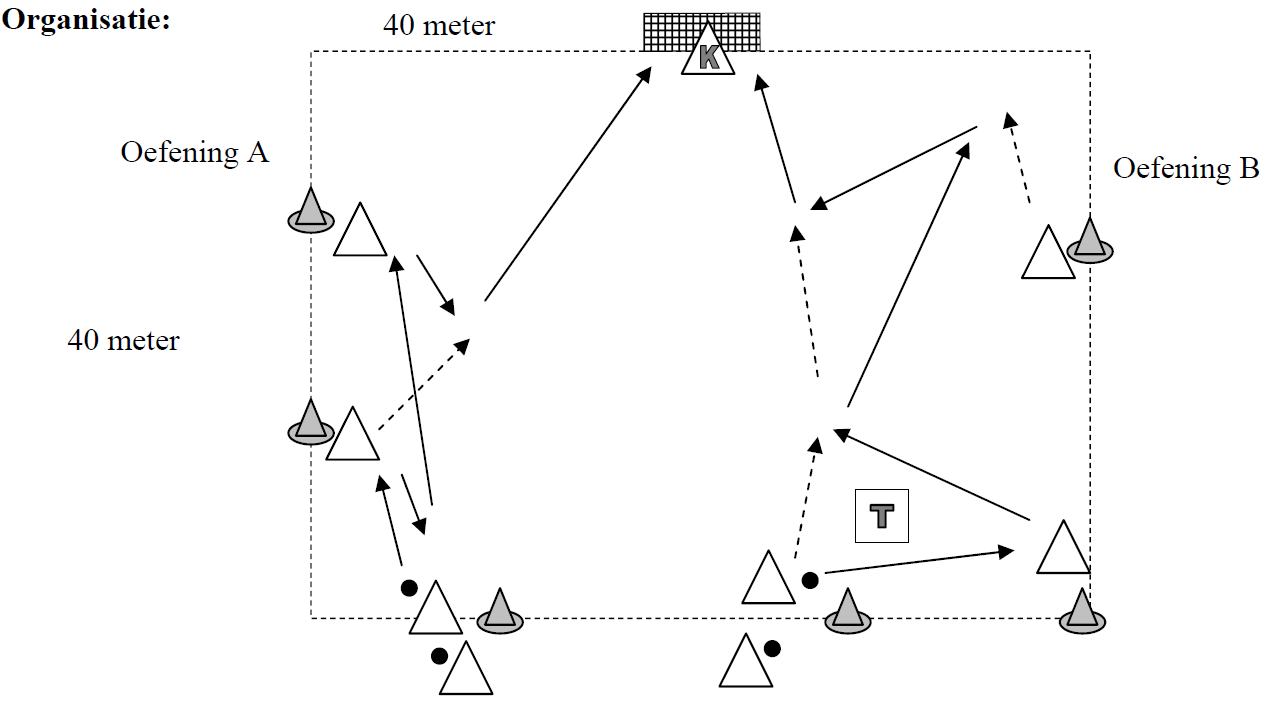
Organization:
- Divide the team into 2 groups, 1 group on the left side and 1 on the right side.
- In exercise A they start with a single handball, then quickly move on to a double handball. The
- The first player then finishes the ball.
- In exercise B the ball is given deep after a 1-2 combination, after which a cross follows. Your
- You can act as a defender here.
- The players move on.
- The players must try to keep the ball low.
Points of attention:
Technical execution of the kick with the inside of the foot
:Stand leg; point in the direction of play; bent in the hip, knee and ankle.
Playing leg; turned outward; knee and ankle bent.
Playing foot; perpendicular to the direction of play; sole of the foot parallel to the ground; toes raised;
no weak ankleon the
kick.
A controlled swinging movement.
Technical execution of the kick with the inside of the instep:
Stand leg; 2 to 3 foot widths next to the ball; bent at the knee.
Tackle; on the inside of the spot where the laces begin.
Approach from an angle of approximately 45º.

Organization:
Divide the team into 3 groups. If you have few players you can also make 2 groups and
leave outa goalie
.
They have to pass the passive defender with a feint and then score.
After this, they move on to the next goal.
After a few rounds, you can indicate that you want to see a particular feint
If you are training in pairs, you can also be a defender yourself Now you can decide for each player how
strongly you will defend
If things are going well, you can instruct the defenders to defend at their very
best
Some comments:
You can use nice feints from professional footballers or the players of Balk 1 as an example
.
Points of attention:
Do not use the passing move too far or too close to the opponent.
The body must move with the passing move for it to be successful.
Requirements: Â- players must be able to dribble a layup run
Goal: Â- Increase offensive power in 1 against 1
Organisation
: Player 1 receives the ball from
33 moves backwards1
unbalances 3, passes and goes hard to the basket Mandate
for the defender is to stop the dribble loser
stays on the same side defender winner
attacks on the oppositeside
Teaching Points
:Attacker should aggressively close the distance Right
at the defender Dribble down the defender
Unbalance the defender Attacker
should be unpredictable
Choosing which side to pass on at the last moment
After
passing, move at full speed towards the basket Play
with guts If
you can't, regain your balance, and try another technique, e.g. backup dribble + jump shot
This is a test, to see if it works (custom version)
This exercise will improve the passing game. We also increase the difficulty by starting the same exercise at two sides. The passing has already been done for the U23 and U12 but can also be used for younger players.
It is a simple form which can be done in a space of 20m by 20m or smaller. If you want the pass line 3 to be longer and tighter, you have to draw it backwards.
A and D start the exercise together by passing to B and E (1), who then pass the ball back (2). A and D run in on the ball and play diagonally to C and F (3). Here, both players have to be careful not to bump into each other, so vista is important in passing. B and E turn around and ask a 1/2 from C and F (4,5). C and F guide the ball further to the starting position to start again (6). The players continue to advance according to the letter.
A-B-C-D-E-F-A.
You can always run this pass at a high tempo. If you have a younger age group which is a bit sluggish, then allow a ball control in the passing.
The fun aspect is always possible too. You place a small goal in the zone of A and D.C and F try to score a goal after the double pass. The one who scores the fastest is the winner.
This time we have put online a game form in which you play 4vs4 in the middle and each team has 2 more players in a neutral zone on the sides. This type of game has been practiced many times by our teams and first teams. With emphasis on fast passing and deep running.
Age category: U14 to U21 and first team.
This type of game can be played on a 15m x 30m pitch. This depends on the age of the players and the pressure they are under. If you want to play in this shorter space, make it smaller. Otherwise, make it bigger. The endzone is about 2 to 3 m deep.
In the middle you play 4vs4 and on both sides both teams have 2 players who have to play in 1 time.
The 4 middle players try to control the ball in the endzone, but the last pass must be made in 1 time.
As you can see on the picture, the ball is played in by the back player to the outfield player (1), who immediately passes (2). The middle player passes to the furthest player (3), and the furthest player looks for the 3rd man in between, who opens up in the deep (4). The latter then checks the endzone to score.
Like in the picture, you can also place fixed cones or dolls as an extra difficulty.
Of course you can increase the number of ball keys according to the age.
There are always extra rules that you can add. E.g. it should not be the 3rd man to score.
This type of game can be used perfectly in your periodization.







